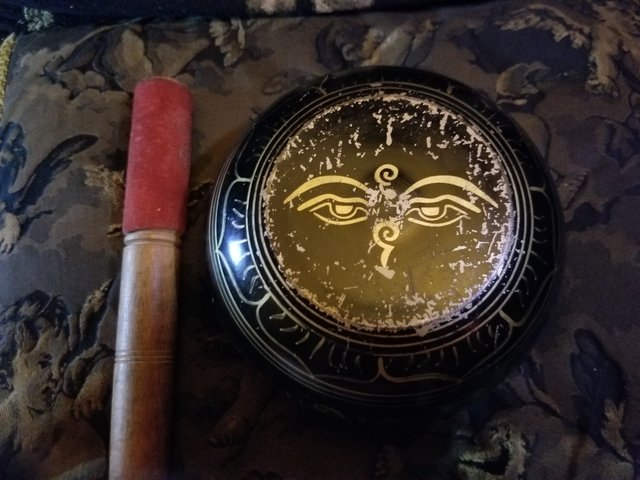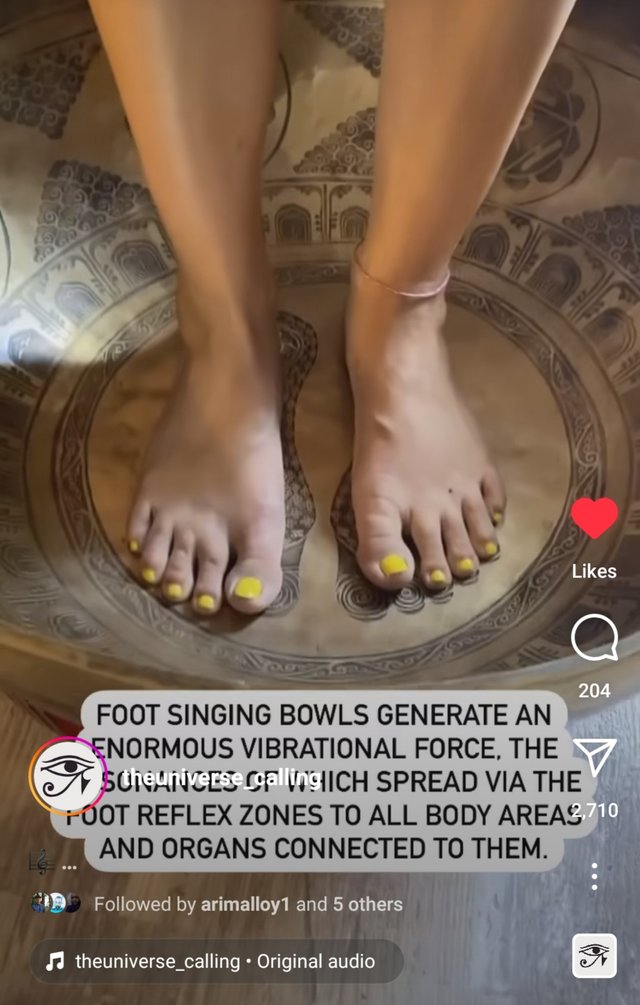






I have a singing bowl for Lam sound, root chakra, measuring at 513.7 hz C5 when struck and 544.3 hz C#5 when ringing. However there is no consensus on what frequency the root chakra is at.
Simple Google search shows different results. "The seed mantra for the Root Chakra is 'LAM' and the elementary frequencies associated with this chakra are 228Hz- 456Hz-912Hz" or 432 hz natural A or 228 hz, 396 hz, etc is being mentioned. So, which one is it?
Let's do basic math. Since the base earth frequency is measured at 7.83 hz, so called Schuman resonance, and the human body vibrates at 33 octaves above it, then that would be the base root frequency whatever it is since am bad at math and sound, however am excellent at logic and visual data.
Here is some articles I found about it:
Solfeggio Frequencies and Chakras
Sound healing is an effective and increasingly popular method for balancing the mind, body, and spirit. One of the most powerful tools in sound healing is solfeggio frequencies.
Solfeggio frequencies are special tones that can positively change your brainwave activity, promote relaxation, and reduce stress. They are also believed to help balance the body’s chakras or energy centers.
If you want to improve your overall well-being, solfeggio frequencies may be just what you need. Listen to solfeggio frequency tracks regularly to see if they make a difference for you.
Solfeggio Frequencies and Chakras: An Introduction
For many years, the ancient solfeggio frequencies were thought to be lost. But in recent years, these powerful sound frequencies have been rediscovered and are now being used by people worldwide to promote healing and balance.
The solfeggio frequencies are a special set of six tones used in medieval music. These frequencies are believed to have a powerful effect on the mind and body. When these frequencies are played, they can create positive changes in brainwave activity, promote relaxation, and reduce stress.
Meanwhile, the chakras are energy centers in the body responsible for our physical, emotional, and spiritual well-being. In Sanskrit, chakra means “wheel” or “disk.”
There are seven main chakras, each of which is associated with a different color and different functions. When these chakras are in balance, we feel healthy and happy. But when they become imbalanced, we may experience physical or emotional problems.
Solfeggio Frequencies and Chakras: How They Work Together
Using solfeggio frequencies can help balance the chakras and promote healing. A growing body of research supports the use of these frequencies for stress reduction, relaxation, and other health benefits.
One study found that listening to solfeggio frequencies can help to lower blood pressure and heart rate. Another study found that solfeggio frequencies can help to reduce pain.
How the Solfeggio Frequencies and Chakras Interact
There are several solfeggio frequencies, each of which is associated with a different chakra. Below, we’ll look at each of these frequencies and how they interact with the chakras.
Root Chakra (frequency: 396 Hz)
The root chakra, also called Muladhara in Sanskrit, is located at the base of the spine. It is associated with feeling grounded, safe, and secure. This chakra is also responsible for our survival instinct. Red is the color associated with the root chakra because it is the color of blood, which is essential for life.
The solfeggio frequency of 396 Hz stimulates the root chakra. This frequency is associated with the feeling of safety and security. It is also said to help with anxiety and fear. The lowest solfeggio frequencies, 396 Hz, can help ground and stabilize us.
Music that contains this frequency allows us to connect to our natural state of feeling safe and secure.
Sacral Chakra (frequency: 417 Hz)
The sacral chakra, or Svadhisthana in Sanskrit, is located just below the navel. It is associated with orange, creativity, pleasure, and sexuality.
Regarding the solfeggio frequencies, 417 Hz is said to help with creative visualization. This frequency can also help to increase our sexual energy and pleasure. When our sacral chakra is in balance, we feel confident and creative. We are able to enjoy our sexuality and our lives.
With the help of 417 Hz, we can connect to our creative side and start manifesting our desires. This frequency can help us let go of old patterns that no longer serve us.
Solar Plexus Chakra (frequency: 528 Hz)
The solar plexus chakra, or Manipura in Sanskrit, is located just above the navel. This chakra, represented by the color yellow, is related to our power, will, and determination. It is also the chakra of our ego.
The solfeggio frequency of 528 Hz stimulates the solar plexus chakra. This frequency is associated with personal power and confidence. It is also said to help with decision-making and manifestation.
Music of this frequency helps us reconnect to who we are. It can also help us to make decisions from a place of strength and mental clarity.

Heart Chakra (frequency: 639 Hz)
When we think of the heart chakra, we often think of love. And while love is certainly associated with this chakra, there is much more to it. That’s why the heart chakra is represented by the color green and not red.
The heart chakra, or Anahata in Sanskrit, is located in the center of the chest. This chakra is associated with our ability to love both ourselves and others. It is also the chakra of compassion, forgiveness, and understanding.
The solfeggio frequency of 639 Hz is said to help us heal old wounds and create relationships based on love and understanding. It is also said to help us connect with our higher self.
Music at 639 Hz can help us to heal old traumas and open our hearts to giving and receiving love.
Throat Chakra (frequency: 741 Hz)
There’s a reason the throat chakra is also known as the communication chakra. This chakra, called Visuddha in Sanskrit, is responsible for our ability to communicate our needs and desires. It is also the chakra of self-expression and creativity. Blue is the color of the throat chakra because blue is often associated with communication and empathy.
The solfeggio frequency of 741 Hz stimulates the throat chakra. 741 helps us to connect to our higher selves and express our authentic voices. It is also said to help with creative visualization and manifestation.
When we listen to music at 741 Hz, we can open up to our higher purpose and begin to express ourselves in more authentic and creative ways.
Third Eye Chakra (frequency: 144 Hz)
Whatever you call it - the third eye, the pineal gland, or the Ajna chakra - this energy center is located in the middle of the forehead. It is associated with our ability to see clearly, both physically and intuitively.
The third eye chakra, colored indigo, is related to the solfeggio frequency of 852 Hz. With music at this frequency, we can open up to our intuition and begin to see things more clearly. It is also said to help with meditation and relaxation.
Those attuned to this frequency can often tap into their psychic abilities and sense things beyond the physical world. Awakening intuition also allows us to see the interconnectedness of all things.
Crown Chakra (frequency: 963 Hz)
The crown symbolizes enlightenment, and the crown chakra - or Sahasrara in Sanskrit - is associated with our highest state of consciousness. This chakra is said to be the gateway to our spiritual selves. The colors associated with the crown chakra are violet and white. This is because violet is the color of spirituality, and white is the color of purity.
The solfeggio frequency of 963 Hz stimulates the crown chakra. This frequency is said to help us connect with the Divine and our highest selves. It is also said to promote feelings of peace and bliss.
When we listen to music at 963 Hz, we can open up to our spiritual side and experience a sense of oneness with the Universe and the spiritual order. This frequency can also help us to let go of our ego and connect with our higher purpose.
https://www.bettersleep.com/blog/solfeggio-frequencies-and-chakras/
This video features Root Chakra Meditation Chant. The seed mantra for the Root Chakra is ‘LAM’ and the elementary frequencies associated with this chakra are 194.18, 256 & 396 Hz The Chanting and music has only the pure resonating frequencies, which help to easily go into a meditative state and stimulate the chakra to bring it to balance.
Few things to know about Root Chakra or Muladhara
The Color Associated with this Chakra is Red. Wearing Red, eating red fruits and veggies, and visualizing Red while meditating really helps in awakening this chakra.
And this chakra is located at the end of your spine. You can imagine a red disc of energy at the end of your tailbone, which is stabilizing you, and energizing your entire body.
Chant ‘LAM’ along with this Video can increase the effectiveness of this meditation multiple times.
As you meditate, close your eyes, and visualize that you are taking Red energy in with each breath, that red energy is getting to every part of your body, and energizing it.
Also, note that this is the primary chakra, the fundamental chakra which needs to be balanced first, before moving to any other chakra.
So make a daily routine, to meditate on this chakra, to balance it first, before moving to next chakra.
We are celebrating “Chakra Meditation Month”, for entire February. Below is the schedule.
Week 1 : Chakra Sleep Meditation Music
Week 2 : Chakra Meditation & Healing Seed Mantra Chants
Week 3 : 7 Chakras Guided Meditation
Week 4 : Chakra Balancing & Healing Music.
We would love for you to join us, here – http://www.youtube.com/TheMeditativeMind
https://steemit.com/singing/@theuniverse.name/singing-bowls-root-lam-chakra-explained

♡
_ \ \ | / / _